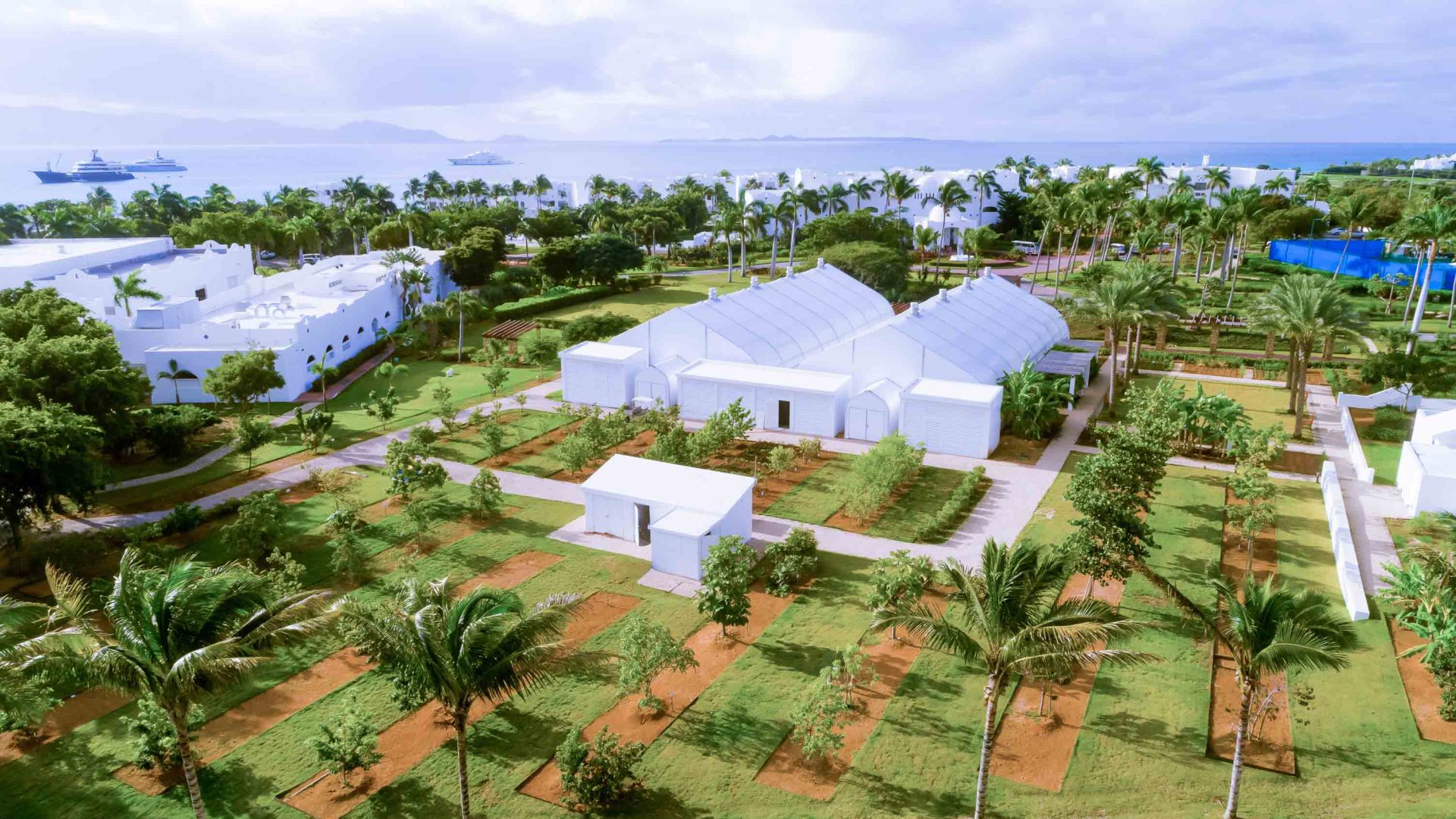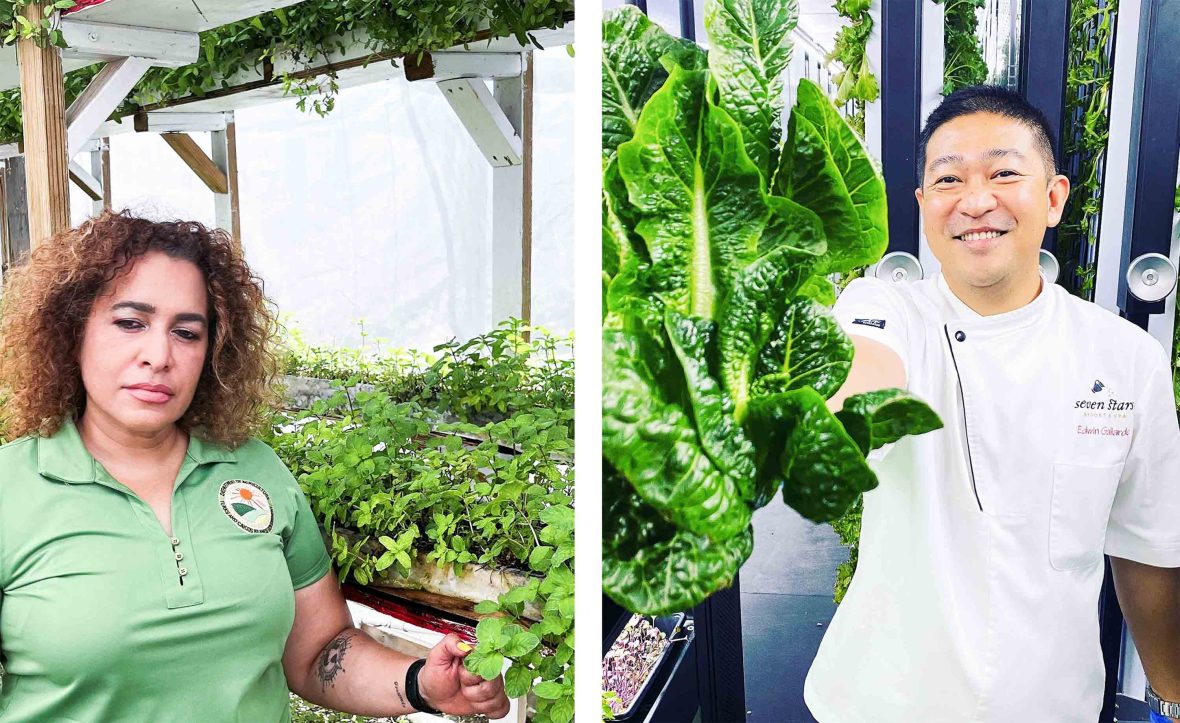
Food waste is a huge issue in the Caribbean, a region that already imports up to 90 percent of its food supply. Mariette Williams meets the chefs and innovators looking for solutions inside shipping containers and soil-free gardening techniques.


Food waste is a huge issue in the Caribbean, a region that already imports up to 90 percent of its food supply. Mariette Williams meets the chefs and innovators looking for solutions inside shipping containers and soil-free gardening techniques.
If you’ve eaten a meal at a Caribbean resort, chances are that most of the ingredients were imported. The World Bank reports that an estimated 80-90 percent of food consumed in the Caribbean is imported—which comes at a steep cost. It’s likely that the fruit salad you ate for breakfast was far from local, and a dinner featuring roasted cauliflower or kale salad is likely to have traveled hundreds of miles before making it to your plate.
And it’s not just about money. Along with the base cost of importing food, food waste is also a concern since fruits and vegetables can often spoil during transit. The World Food Programme reported that nearly a third of food produced each year is squandered or lost. If wasted food were a country, it would be the third largest contributor of carbon dioxide behind China and the United States.
But with growing awareness and a desire to face these challenges head-on, several chefs and farmers in the Caribbean are starting to do things differently—and some have turned to hydroponic gardens in an effort to reduce waste, cut down on import costs, and embrace sustainability.
Hydroponic gardening is a method of growing plants in a water-based nutrient solution instead of soil. It has many tangible benefits, such as less food waste due to little to no transportation, a greater yield of crops, and less water used compared to traditional farming. After creating a rooftop garden of the Seven Stars Resort and Spa in Turks and Caicos, chef Edwin Gallardo was motivated to look further into sustainability efforts—so he pioneered a hydroponic freight farm inside a shipping container at the resort.
“The freight farm is a vertical farming system which is user-friendly and makes sense for Turks and Caicos,” he tells me. “Soil and water are some of our biggest challenges, and we also have to factor in our weather. It would be difficult to go the route of traditional farming because of things like hurricanes, and a freight farm provides a controlled environment.”
“When we waste food, we also waste all the energy and water it takes to grow, harvest, transport, and package it.”
- Wilhelmina Kissoonsingh
Maintaining a hydroponic farm also takes up less water and land space, plus crops have a shorter yield time compared to traditional farming. “We have a very limited supply of fresh, potable water available for growing food,” says Wilhelmina Kissoonsingh, Director of Agriculture in the Turks and Caicos Islands.
“In a hydroponic system, water can be captured and re-used to grow other food crops,” she adds. “Also, the carbon footprint is minimal as the greens are grown locally, so ‘food miles’ are significantly less for the transport of food from farm to market.”

Cutting down on transportation time is one of the key advantages of hydroponic gardening. Chef Gallardo says it takes an average of three to four days for a container of lettuce to ship from Miami—and by the time the produce reaches Turks and Caicos, often half of the shipment is unusable. And, he tells me, if there are supply chain disruptions, transportation times increase, creating more food waste.
“When we waste food, we also waste all the energy and water it takes to grow, harvest, transport, and package it,” Kissoonsingh adds. “And if food goes to the landfill and rots, it produces methane, a greenhouse gas even more potent than carbon dioxide. Cutting down on food waste is important to reduce greenhouse gas emissions and conservation of energy.”
Gallardo is able to grow over 12 different lettuce varieties, herbs, and microgreens in his vertical freight farm inside a 320-square-foot shipping container. Its harvest is then served at The Farm, a farm-to-table restaurant with dishes made with ingredients grown in the hydroponic garden.
The difference in taste in imported food versus hydroponically farmed food is remarkable too. On a recent visit, I stopped by Gallardo’s garden where we picked butterhead and Romaine lettuce straight from the vertical garden. The butterhead leaves were tender and sweet and the Romaine lettuce was crisp and tart, compared to imported lettuce which is often tough or flavorless after days or weeks spent in transit.

Hydroponic gardening can also be adopted beyond resorts, providing residents a way to support themselves and decrease reliance on expensive, imported vegetables. In Jamaica, Ricardo Chambers, former Olympic athlete and the owner and operator of Chambers Hydrofarms, is on a mission to transform Jamaica’s agricultural landscape.
Chambers comes from a family of farmers and grew up in Trelawny in Jamaica’s northern region. He says that hydroponics is the future of agriculture globally and could solve many problems that arise due to climate change like drought.
“Hydroponic gardening is the best way to go in the Caribbean. It’s effective, cost-effective, and not so labor-intensive.”
- Chef Edward Gallardo
“You can grow just about anything hydroponically,” Chambers explains. “With our system, we grow produce like tomatoes, cabbage, string beans, strawberries and sweet peppers. There’s not much labor required, and because hydroponic gardens are built locally, the fruit tastes fresher compared to imports.”
Chambers also supplies hydroponic kits for commercial and residential use, helping families make sure they have access to fresh vegetables right in their backyards. Chambers has also established a mentorship program for young Jamaicans to learn entrepreneurship and self-sufficiency through hydroponic gardening.
Nearly a thousand miles east of Jamaica, Anguilla’s residents face similar obstacles to cultivating fresh fruits and vegetables because the island is generally not suitable for growing crops and lacks an adequate freshwater supply. Wanting to provide the freshest ingredients for guests, the Aurora Anguilla Resort & Golf Club established a 10,000-square-foot farm, including a hydroponics system, which provides 90 percent of the ingredients used at the resort.
The hydroponics manager, Rohan Maynard, extols the benefits of hydroponic farming, emphasizing its ability to yield high-quality food and take up less space than a traditional garden. “Aurora Anguilla’s self-sustaining hydroponic farm is the backbone of the resort’s dining experience,” he says. “The tomatoes and peppers are vine-ripened to give maximum nutritional value and a ‘backyard’ flavor. The lettuce is very tender with a mild flavor, and our fresh tomatoes are used in pasta and pizzas, and served fresh in salads. We also grow all our herbs that are always fresh in all our dishes.”
Maynard also says food grown on a hydroponic farm doesn’t use the harsh herbicides and pesticides used on many commercial farms, and food waste is minimal because harvests are protected from larger pests and extreme weather. Echoing Gallardo, Maynard emphasizes how the hydroponic garden produces food all year, providing a win for the environment, chefs and resort guests.
“Hydroponic gardening is the best way to go in the Caribbean,” Gallardo tells me. “It’s effective, cost-effective, and not so labor-intensive. Because it’s a controlled environment, there are no insects and you can grow any leafy greens here. This is the best way for us to be sustainable for the foreseeable future.”
***
Adventure.com strives to be a low-emissions publication, and we are working to reduce our carbon emissions where possible. Emissions generated by the movements of our staff and contributors are carbon offset through our parent company, Intrepid. You can visit our sustainability page and read our Contributor Impact Guidelines for more information. While we take our commitment to people and planet seriously, we acknowledge that we still have plenty of work to do, and we welcome all feedback and suggestions from our readers. You can contact us anytime at hello@adventure.com. Please allow up to one week for a response.

Mariette Williams is a freelance writer living in South Florida. Her work has appeared in many well-known publications such as Condé Naste Traveler, Travel+Leisure, AFAR, Bon Appetit across topics that include travel, culture, books and wellness. When she's not traveling, she's lost in a good book.








Can't find what you're looking for? Try using these tags: